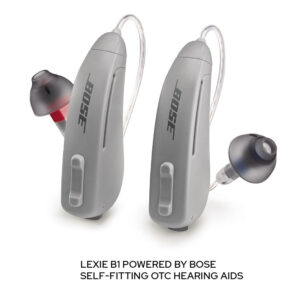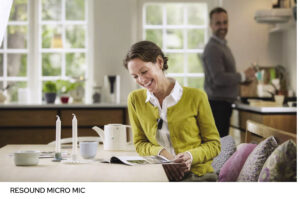
Katie Colt is a writer living in the Chicago area. Her work can be found at The Huffington Post, The Washington Post, and more.
From microphones to OTC hearing aids, know the options available to help you hear better
The world of hearing accessories is vast and wide, and the population of people who use them is just as diverse. Nearly 48 million Americans have some degree of hearing loss, from mild to profound, according to the Hearing Loss Association of America.
Before exploring the world of hearing accessories, undergo a hearing evaluation to find out exactly what would work best for you. And for caregivers, it’s important to make sure the person you’re caring for takes that first step if you suspect they may need hearing help.
Caregivers should be present for the hearing exam and explanation of how to use any recommended or prescribed devices. Brittney Sprouse, AuD, audiologist and department manager for audiology at University of Chicago Medicine, says signals get crossed when people come to appointments without caregivers or family to help them operate the devices.
“We’re more than happy to get them involved because we want the person with hearing loss to be able to hear and to be successful in whatever environment that they’re in,” Sprouse says.
Read on for a round-up of common hearing accessories.
Over-the-counter hearing aids
 The FDA approved the sale of over-the-counter (OTC) hearing aids in 2022, making them more accessible to the public. These in-ear amplifiers take an environment’s sound and turn up the volume. They’re good for people who have mild to moderate hearing loss.
The FDA approved the sale of over-the-counter (OTC) hearing aids in 2022, making them more accessible to the public. These in-ear amplifiers take an environment’s sound and turn up the volume. They’re good for people who have mild to moderate hearing loss.
“They were designed to be the first line of defense where patients can purchase these devices and fit them themselves,” Sprouse says.
Yet, OTC hearing aids have downsides, too. Some are just as expensive as prescription pairs. Plus, consumers may not have the option of trialing a device before deciding to commit, or receiving assistance from a professional who might offer more personalized options.
Marie Vetter, AuD, owner of Chicago Hearing Services, says that consumers should check any OTC product for its return policy. And there are people for whom OTC hearing aids are not recommended: They’re not for people with ringing in their ears (tinnitus), ear pain, dizziness, severe hearing loss, or recent changes to their hearing, she says.
Traditional hearing aids
When conducting hearing assessments, audiologists weigh each individual’s lifestyle and daily activities to determine which hearing aid is best suited for them. The main advantage to traditional hearing aids is their ability to be fine-tuned for unique needs.
Vetter says traditional hearing aids are best suited for people struggling to hear in noisy environments, people with tinnitus, and people who experience listening fatigue. She also recommends looking out for family members who have begun to isolate themselves or withdraw from social interactions because they’re struggling to participate in conversations; they also may be candidates for traditional hearing aids.
Captioned telephone service (CTS)
Even with the best hearing aids and hearing care, some people struggle to understand speech clearly on the phone. In phone conversations, they lack visual cues, such as lip movements and facial expressions which help fill in the blanks, according to Lara Bruce, CaptionCall Outreach Manager.
 Telephone captioning, a no-cost, federally funded service via the Americans with Disabilities Act, helps people with hearing loss who need captioning to communicate effectively on the phone. The service is available for home phone and cell phone use. It provides real-time texts of phone conversations, allowing the user to read the words the other person is saying in real time, and may use a live operator on the call.
Telephone captioning, a no-cost, federally funded service via the Americans with Disabilities Act, helps people with hearing loss who need captioning to communicate effectively on the phone. The service is available for home phone and cell phone use. It provides real-time texts of phone conversations, allowing the user to read the words the other person is saying in real time, and may use a live operator on the call.
Individuals can receive a captioning phone with a screen that displays the captions during each call. Mobile captioning apps are available for those who use Bluetooth to stream their calls from their smart phone directly to their hearing aids.
Remote microphones
Remote microphones are small and easy to use. Some mics have multi-use function, where they can be attached to the person speaking or placed on a table if multiple people are talking.
“If you and I are having a conversation and I was wearing a hearing aid, I could have you wear this microphone, and it would transfer what you’re saying directly to my hearing device, wirelessly and directly via Bluetooth,” Sprouse says.
 Using a remote microphone in a complex listening environment, like a restaurant or crowded room, helps improve the signal-to-noise ratio for the hearing aid user. This means that they hear more of the sound they want to, rather than the ambient noise they don’t want to hear. Remote mics are good for the person who needs more specific focus on a certain output, like for a senior needing to hear a caregiver’s voice, a dining partner in a restaurant, the music they’re playing, or the television they’re watching, Sprouse says.
Using a remote microphone in a complex listening environment, like a restaurant or crowded room, helps improve the signal-to-noise ratio for the hearing aid user. This means that they hear more of the sound they want to, rather than the ambient noise they don’t want to hear. Remote mics are good for the person who needs more specific focus on a certain output, like for a senior needing to hear a caregiver’s voice, a dining partner in a restaurant, the music they’re playing, or the television they’re watching, Sprouse says.
Personal amplification device
Personal amplifiers are very affordable but not necessarily practical for frequent or constant use. To use the device, the listener points the mic at the speaker, which amplifies the sound to a pair of headphones or earbuds for the listener.
“It’s something that’s really great for nursing homes to have on hand where you might not know exactly what the individual’s hearing loss is, or they’re unable to get tested,” Sprouse says.
Vetter calls pocket talkers a temporary solution — if a patient is in hospice, for example, and they want to hear what the doctor says when they come to visit. They aren’t recommended for everyday use, but they are inexpensive.






